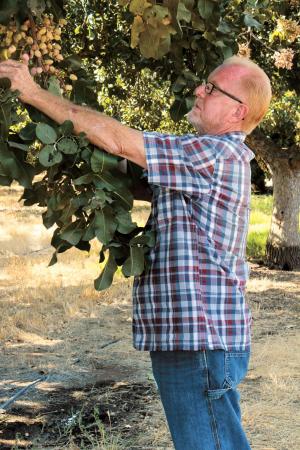2017 - Volume #41, Issue #6, Page #10
[ Sample Stories From This Issue | List of All Stories In This Issue | Print this story
| Read this issue]
They Collect Pollen For Orchards, Chefs
 |
His company has been in the business of collecting and selling pollen for more than 30 years. Founder David Rebb Firman learned about pollen from his grandmother, Mina T. Firman, who began collecting pollen in 1933. While many of her methods, including hand harvesting, are the same today, new technologies such as electrostatic spraying promise to boost pollen’s benefits even more, Woolley says.
Typically, trees have more than enough pollen. A mature almond tree, for example, has as many as 350,000 flowers.
“If growers set just 25 percent of the flowers, they will have a huge crop,” Woolley says.
But soil and weather conditions can affect how much of the pollen is effective. By gathering pollen and distributing it in a timely manner, there is more pollen for bees to move and a better chance for increasing yields.
Between mid-February and early May, workers gather pollen from healthy orchards. Orchard owners are paid per acre. Almond trees are shaken, and some of the flowers (in the popcorn stage where the petals are closed around the pollen anthers) fall and are collected. The flowers must be handpicked on other trees including pistachio, cherries, peaches, kiwis, and so on.
Barrels of flowers are taken to a processing plant where they go through a machine that removes the petals. The pollen is dried, then screened, cleaned and frozen in gallon freezer bags. Within days it is shipped to customers, mostly in the San Joaquin Valley of California. Pollen is dispersed by blowing it through a machine into the crown of a tree and/or by placing pollen in beehive inserts so that bees crawl through the pollen when they leave the hive. Providing additional pollen makes it possible for fewer bees to move more pollen.
Pollen prices vary according to species, but the biggest seller is almond, which sells for $1.75/gram.
“We recommend 80 to 100 grams/acre in 3 applications,” Woolly says. But often producers add 60 to 80 grams/acre in 2 applications (30 to 40 grams/acre each time).
Woolley notes that the whole process from collecting pollen to dispersing it occurs in a concentrated period of time from 3 to 10 days.
He predicts even better yields in the future based on research over the past six years with wet electrostatic application, a solution that suspends pollen and places it right on the flower’s pistil.
“It’s really phenomenal. We get 30 to 80 percent yield increases,” he says.
Besides increasing fruit and nut yields, the company has developed a market for fennel pollen, used as a spice in cooking.
Contact: FARM SHOW Followup, Gary Woolley, Pollen Collection and Sales, P.O. Box 44090, Lemon Cove, Calif. 93244 (ph 559 802-8991; www.pollencollectionandsales.com).

Click here to download page story appeared in.

Click here to read entire issue
To read the rest of this story, download this issue below or click here to register with your account number.




